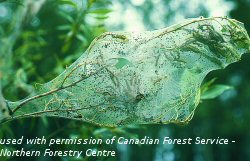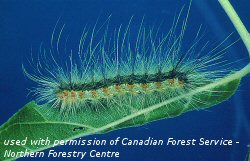Fall Webworm (Hyphantria Cunea)

Fall webworm nest

Fall webworm larva
Host Plants And Distribution
The fall webworm feeds on a variety of hosts, including chokecherry, birch, willow and elm. It is found in all areas of Canada and the northern United States.
Biology
The fall webworm has one generation per year. Adult moths are white and are active from late June to mid-July. Females lay eggs on the underside of leaves of the host plant. Eggs hatch about two weeks after being laid and larvae feed within nests constructed of foliage and silk. The nests that are formed are very similar in appearance to those of the ugly nest caterpillar and are difficult to tell apart. The larvae are covered with long silky hairs that arise in tufts from the tubercles. They are pale yellow with a broad black band across the back. Larvae feed throughout the summer and when mature, seek out sheltered spots for pupation. Cocoons are woven and the pupae overwinter.
Symptoms and Damage
Larvae construct silken tents at the top of individual plants. Foliage is webbed together to form a nest that the larvae feed, defecate and pupate in. Nests may cause some branch deformity in years following infestation but otherwise cause little permanent damage. Nests are very unsightly in orchard and ornamental plantings.
Scouting Techniques
Nests are very obvious and easily located by visual inspection. Checking the orchard weekly for developing nests should allow for early detection.
Economic Thresholds
No economic thresholds have been established for this insect. It is difficult to tell the nests of the fall webworm from those of the ugly nest caterpillar. Treatment of both nests is the same. Infestations can be controlled by pruning and destroying nests.
